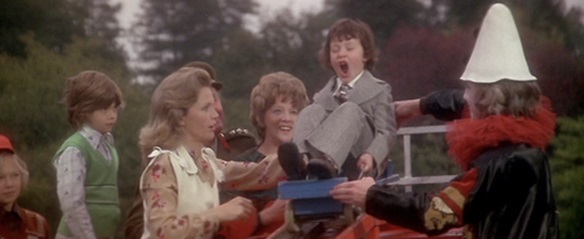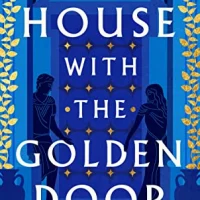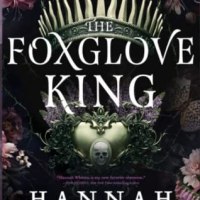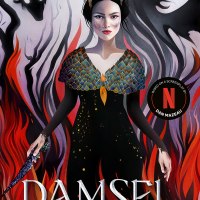Guest Post: “My Favourite Creepy Children” by Tim Major
Today we’re very happy to present a very special treat! Earlier this year saw the release of Hope Island by Tim Major, a novel described as a thought-provoking exploration of family, identity, and community. Nina is a workaholic mother struggling to keep everything in her life together after her partner Rob walks out on her, traveling to a beautiful but remote island with her teenage daughter Laurie in order to reconnect with family. But once there, they find a world full of mystery, strangeness…and creepy children. And on this subject, Tim has very graciously written us an awesome guest post that I hope you will find as fascinating and fun to read as I did! Hope you’ll enjoy it, and be sure to check out Hope Island, available now from Titan Books.
![]()
MY FAVORITE CREEPY CHILDREN
by Tim Major
 My favourite creepy children are my own two sons. What I’m saying is that all children have the capacity to be creepy. When they were younger one or the other of them might shout in the night, and when I’d enter their room they might be standing upright in their cot, staring in the darkness, and then scream at me to leave.
My favourite creepy children are my own two sons. What I’m saying is that all children have the capacity to be creepy. When they were younger one or the other of them might shout in the night, and when I’d enter their room they might be standing upright in their cot, staring in the darkness, and then scream at me to leave.
My novel, Hope Island, is about an island community off the coast of Maine, where the children are behaving decidedly creepily. British mother Nina Scaife is only a visitor to the island, but once her daughter, Laurie, befriends the group of children, it’s inevitable that Nina will become embroiled.
I had fun writing these children. A kind of fun, anyway. The scratching of an itch. I worked through a bunch of my parental anxieties.
For this article I’d initially intended to present a survey of creepy children in fiction, particularly films. But last night I tried to watch the 1980 Troma film The Children, featuring atomic children who kill by hugging, and recently I attempted a viewing of the 1894 adaptation of Stephen King’s Children of the Corn, but couldn’t manage to sit through either of them, and I couldn’t even get hold of a copy of The Bad Seed (1956).
So this is not comprehensive list. Consciously or unconsciously, these are some the fictional children I (probably) drew upon while writing Hope Island.
The Midwich Cuckoos
I read John Wyndham’s 1957 novel The Midwich Cuckoos when I was about 11 years old, just after reading his The Day of the Triffids and H. G. Wells’ The Time Machine and The War of the Worlds. As with other Wyndham novels, there are two phenomenon vying for centre stage. At first, the mystery is that the entire population of the village of Midwich have fallen asleep spontaneously. The xenogenetic pregnancies, and the identical children produced, come later. Being identical, there’s little characterisation of the children of Midwich. Their creepiness is the product of this eerie similarity, synchronised movements, and their burgeoning ability to control minds. I saw the 1960 film adaptation, Village of the Damned, much later, but I like it very much. Less so the sequel, Children of the Damned (1964), but it still has its moments.
Who Can Kill a Child?
This 1976 Spanish horror film (original title ¿Quién puede matar a un niño?) featured in Mark Gatiss’ 2010 documentary series A History of Horror, which is where I learned about its existence. Retrospectively it was a huge influence on Hope Island, featuring as it does English tourists already out of their depth even before they encounter the inexplicably feral children. A couple of scenes from the film are particularly striking, including a high-angled shot of the children in a bay, which, now that I think about it, probably explains why the first dead body in my novel is discovered in similar circumstances.
Dark Season and other horrific children’s fiction
Still, in my opinion, Russell T Davies’ finest hour, the first story in this short-lived 1991 Children’s BBC serial featured schoolchildren brainwashed by computers gifted to them by a mysterious company. I was 11 at the time and, after reading The Demon Headmaster by Gillian Cross and Grinny by Nicholas Fisk (both in whole-class readthroughs – my primary-school teachers had no qualms about terrifying us at a young age), I was primed for paranoia and a deep mistrust of both adults and my fellow classmates. The first Doctor Who episode I ever saw was the first episode of Remembrance of the Daleks in 1988, in which an unbearably creepy schoolgirl who chants nursery rhymes as she skips through the playground of Coal Hill School, and then murders people indiscriminately. You could say I was predisposed to channel all these early experiences of fictional horror, and that it was only a matter of time before I wrote Hope Island.
The Omen
Probably my first experience of truly adult horror featuring creepy children. Actually, no – my first horror film was Poltergeist (1982), and little Carol Anne’s possession and “They’re here…” announcement is genuinely unnerving. But The Omen (1976) was a particular milestone, shifting my attitude to horror films from an ordeal to endure to an ordeal in which to delight. My sister and I started watching The Omen when it was screened in a late-night TV slot, and it was horrific, and then she decided to go to bed, leaving me alone and terrified. I don’t think I’ve really recovered. Now, it’s the scenes at the beginning of the film of Damien’s fifth birthday party that linger in my mind – his superficial cuteness, his malign influence on his doomed nanny. Only Don’t Look Now (1973) challenges The Omen for terror, though the creepiness of the young girl in that film is due to her absence.
The Lord of the Flies
It’s now clear to me that my personal cornerstones of creepy children in fiction relate to experiences during my school years. William Golding’s 1954 novel The Lord of the Flies was another book that I first read at school, around the age of 13. And it’s horrific, of course. What were my teachers thinking? While there are no supernatural goings-on here (—and are there supernatural goings-on in Hope Island, I hear you ask? There may well be), the cruelty of children towards fellow children is front and centre, and of course the island location is key to the scenario. And I’m sure that I wasn’t the first reader to fear for the safety of the British naval officers who arrive at the island at the end of the book to discover these feral, warlike children…
![]()
Tim Major is a writer and editor from York, UK. His love of speculative fiction is the product of a childhood diet of classic Doctor Who episodes and an early encounter with Triffids.
Tim’s earlier novels and novellas include Snakeskins, You Don’t Belong Here, Blighters, Carus & Mitch, the YA novel Machineries of Mercy, the short story collection And the House Lights Dim, and a non-fiction book about the silent crime film, Les Vampires. His shorts have appeared in Interzone, Not One of Us and numerous anthologies including Best of British Science Fiction and The Best Horror of the Year.
Find out more about Tim at www.cosycatastrophes.com or on Twitter at @onasteamer.
















Bwahaha Mogsy! Love this! Yes children can be creepy and yes my son too had these night terrors. I would never be able to watch these movies! Too chicken.
LikeLike
The combination of childish innocence with supernatural horror is one of the most striking indeed and I understand how it can leave its mark on any reader/viewer…
Thanks for sharing! 🙂
LikeLike
What a great guest post. Creepy children are the best!
LikeLike
Thanks for sharing, that’s interesting!
LikeLike
Lol… a great article – and I’m with Tim – WHAT are teachers (or more accurately – curriculum setters) thinking of?? I remember a whole bunch of Year 4 children (8 & 9 years olds) seriously traumatised by The Iron Man by Ted Hughes!
LikeLike
Pingback: HOPE ISLAND articles from around the web | Cosy catastrophes
Ohh no! Creepy kids, they are always so much creepier when kids
LikeLike
This has me thinking back to my own childhood. I remember being creeped out often enough, but were there instances where I was the one creeping someone else out? Brings a sick but satisfied smile to my face. 🙂
LikeLike
Hahah – this is great. I love the Village of the Damned. I had a phase of watching B&W films and that was one of them.
What about ghost children?? The twin girls out of The Shining for exmple? brrrr.
Lynn 😀
LikeLike
Village of the Damned is suuuuuch a classic, love that one!
LikeLike
Pingback: Bookshelf Roundup 08/01/20: Stacking the Shelves & Recent Reads | The BiblioSanctum